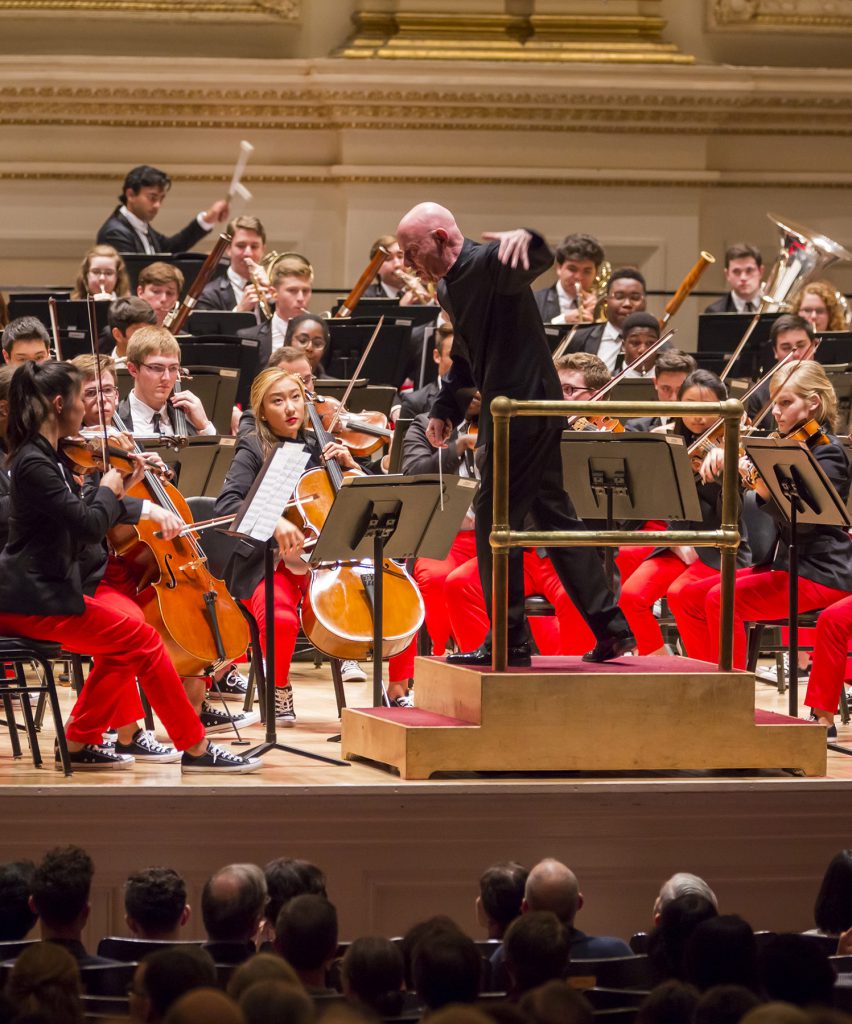Eschenbach, National Youth Orchestra of USA scale the heights with Bruckner

Christoph Eschenbach conducted the National Youth Orchestra of the United States of America Thursday night at Carnegie Hall. Photo: Chris Lee
Instead of joining the hand-wringing about the so-called death of classical music, Carnegie Hall’s Weill Music Institute is actually doing something about it.
In 2013 the Weill Institute launched the National Youth Orchestra of the United States of America. Every summer, following a comprehensive audition process, the group’s members—coming from all over the country—study with mentors from professional orchestras, then tour some of the world’s great music centers to show off their expertise. Valery Gergiev led the ensemble in its inaugural concerts, followed by David Robertson in 2014 (also the group’s Carnegie debut), and Charles Dutoit in 2015.
Last night, the conducting honors fell to Christoph Eschenbach, currently music director of the National Symphony Orchestra and the John F. Kennedy Center for the Performing Arts. Leading an impassioned, highly focused group of over 100 young players (ages 16-19), Eschenbach not only gave a memorable evening for a packed Carnegie Hall, but provided further evidence of the formidable prowess of today’s young musicians.
The party began with Mozart’s Piano Concerto No. 22, with Emanuel Ax in lithe form (despite looking a little fatigued while making his way onstage). Using moderate tempos, Eschenbach showed grace and warmth, with special attention to tapering at the end of phrases. In the second movement, muted strings created a veil of grisaille, heightening Ax’s sparkling line. Midway, a lovely interlude with the winds and the four string principals had pleasing transparency, all the way through to the deft final measures.
In the third movement, Ax’s playing was clean and focused, with Eschenbach choosing moderate tempos and encouraging the group to hold back slightly for an ideal balance. The pianist made the most of the ticklish finale.
It is hard to imagine a group of young players tackling Bruckner, but in Eschenbach’s patient hands, they consistently found the sweet spot in the composer’s Sixth Symphony. In the first movement, with the orchestra galloping along toward majestic peaks, luminosity combined with bloom and resonance for results that would rival many professional ensembles. (It would be interesting to know how many in the group had ever played any Bruckner before.) Eschenbach encouraged clean articulation, with timpani as the magnetic heartbeat and brass barely peeking through the clouds, until the glorious conclusion.
As the second movement began, thoughts drifted to a question an acquaintance answered years ago, “What is the most beautiful thing in classical music?” His reply was “Suspensions”—the slight dissonance produced when a note is held over before a chord change resolves.
The Adagio of the Sixth, marked “sehr feierlich” (“very solemn”), is filled with such moments. Eschenbach let the expansive lines flow, sometimes almost to the breaking point, but always ensuring that the main melodic material was in slight relief against the sometimes massive canvas. An alluring wind section didn’t hurt, either. To be fair, one could sense that the conductor’s leisurely tempos were testing the patience of some in the audience, but then, Bruckner’s pace seems to divide listeners anyway. In any case, Eschenbach admirably captured that Brucknerian ache—that sense of fingertips gently touching the sublime—and the orchestra responded with both commitment and restraint.
In the Scherzo, marked by gutsy, urgent work, it was again heartening to see young performers giving the material maturity well beyond their years. The gentle Trio section made a serene idyll.
The finale opens with hushed scurrying, soon interrupted by brass sprays that eventually explode in splendor. Whispers are chased by roars. In particular, the orchestra’s horn section did heroic work in Bruckner’s treacherously written parts, which can flummox players of any age. The strings, cohesive all evening, sounded even more unified here. As he did throughout the symphony, Eschenbach made the most of the composer’s contrasts, reaching the final page with impressive intensity.
When the curtain call began, with most in the audience standing and cheering, Eschenbach motioned first to the horns, and then to the trumpets, trombones, and tuba. Bruckner can be a big bite for some audiences: as Janet E. Bedell wrote in the program notes, “listeners must adjust their 21st-century clocks.” But as each component of the ensemble basked in its portion of the warm ovations, it was hard not to think that the future of classical music is in exemplary shape.







Posted Jul 15, 2016 at 8:58 pm by Brian Moran
I was at the concert and your review is spot-on. The Bruckner matched – maybe exceeded – in impact Eschenbach’s performances with the National Symphony a few years ago. Eschi and the young orchestra seemed to be feeding on each other’s intensity.
Bruckner isn’t everyday fare for youth orchestras, and some in the audience seemed befuddled by it. But after those final ceiling-shaking chords of the symphony, I think everyone in Carnegie Hall knew they had heard a very special concert. Best wishes for the orchestra’s upcoming concerts in Europe with Gergiev
Posted Jul 16, 2016 at 6:14 pm by Judy Moore
Great performance. For David Bender we are so proud